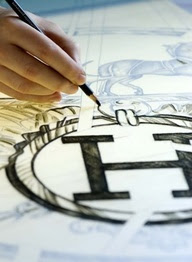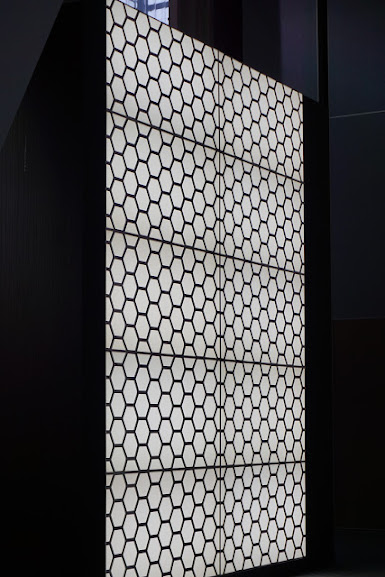Why In Design column is back in time for summer...The beautiful art form of Marquetry made modern
Monday's
Why In Design
column is back,
column is back,
and just in time for summer!
circa 1685 writing desk at the Metropolitan Museum of Art by French engraver, Jean Berain. The piece is made of oak, pine and walnut veneer with ebony, rosewood, and marquetry of engraved brass on tortoiseshell, gilt bronze and steel, and one of the surviving pieces commissioned for Louis XIV's private use at Versailles.
the age-old art form
is at once detailed and elaborate
but can also be heavy and ornate. Additionally, Marquetry has sometimes been called
"painting with wood"
in that the designs resemble a painting.
What is Marquetry?
"Marquetry (also spelled as marqueterie) is the art and craft of applying pieces of veneer to a structure to form decorative patterns, designs or pictures. The technique may be applied to case furniture or even seat furniture, to decorative small objects with smooth, veneer able surfaces or to freestanding pictorial panels appreciated in their own right".
~Wikipedia~
When I studied interior design at Parsons School of Design in the 1990s I had the good fortune of taking a class in the history of decorative arts with Elizabeth Boudreau, who taught us much about the makings and history of antiques. While leading us through the historic halls of NYC's finest museums, Boudreau taught us lots about the history of decorative arts.
Utilizing her wit and humor, Boudreau often chanted a sing-song line to pique our interest...
"Marquetry, Parquetry and Ormolu tell a story about the history of antique furniture"
History of Marquetry:
Believed to have been first created during the 16th century in Italy, the skill of Marquetry was honed in Flemish centers by fine cabinet makers. These furniture makers perfected the art by creating intricate designs of cut, thin wood, some dyed and other pieces natural then arranged together to create detailed works of art. Marquetry can still be seen on the furniture and walls of many churches and cathedrals throughout Europe. During the Renaissance era, Marquetry was heavily practiced then over various historic time periods it went in and out of favor. It reached a feverish pitch in popularity during the Louis XIV period when European royalty began collecting the ornate pieces. It is painstakingly time consuming to create, and it is also gorgeous, detailed, expensive and takes great artistic skill. It is no wonder the technique's popularity waned during the Industrial Revolution, when sleek, modern designs became the rage. Marquetry was overlooked for quite some time for more unembellished furniture, but thankfully we appreciate the art form and it is back with a modern twist. Today, Marquetry can be incorporated into our homes while showcasing the beauty and delicacy of this gorgeous art, yet in a way that reads fresh and new.

courtesy via Andrew Testa for New York Times
A glimpse of modern interpretations of Marquetry -- take a look at this commissioned room which appeared in the New York Times. The Eltham Palace in England was purchased by Stephen Courtauld in 1933. Seely and Paget architects, along with other design teams, were commissioned to create this room. The end result is a stunning Swedish Art Salon for entertaining, with a concrete and glass dome above set against Australian marquetry paneling, which are historic scenes from Venice and Stockholm!
Take a look at five unique pieces of marquetry created by current and talented craftsmen in the industry.
Utilizing her wit and humor, Boudreau often chanted a sing-song line to pique our interest...
"Marquetry, Parquetry and Ormolu tell a story about the history of antique furniture"
History of Marquetry:
Believed to have been first created during the 16th century in Italy, the skill of Marquetry was honed in Flemish centers by fine cabinet makers. These furniture makers perfected the art by creating intricate designs of cut, thin wood, some dyed and other pieces natural then arranged together to create detailed works of art. Marquetry can still be seen on the furniture and walls of many churches and cathedrals throughout Europe. During the Renaissance era, Marquetry was heavily practiced then over various historic time periods it went in and out of favor. It reached a feverish pitch in popularity during the Louis XIV period when European royalty began collecting the ornate pieces. It is painstakingly time consuming to create, and it is also gorgeous, detailed, expensive and takes great artistic skill. It is no wonder the technique's popularity waned during the Industrial Revolution, when sleek, modern designs became the rage. Marquetry was overlooked for quite some time for more unembellished furniture, but thankfully we appreciate the art form and it is back with a modern twist. Today, Marquetry can be incorporated into our homes while showcasing the beauty and delicacy of this gorgeous art, yet in a way that reads fresh and new.

courtesy via Andrew Testa for New York Times
A glimpse of modern interpretations of Marquetry -- take a look at this commissioned room which appeared in the New York Times. The Eltham Palace in England was purchased by Stephen Courtauld in 1933. Seely and Paget architects, along with other design teams, were commissioned to create this room. The end result is a stunning Swedish Art Salon for entertaining, with a concrete and glass dome above set against Australian marquetry paneling, which are historic scenes from Venice and Stockholm!
Happy Nesting
XO TamaraTake a look at five unique pieces of marquetry created by current and talented craftsmen in the industry.
1. Waters and Acland
this piece is inspired by the lifestyle of the glamorous Art Deco era, when marquetry was hugely in favor. It shows fine quality and fastidious detailing, and the unique piece would make quite a statement in a modern home. Waters and Acland is an award winning commercial fine furniture school and furniture making company based in the English Lake District of the UK.
2. Lucy Turner's
Bermuda Blue Bird Sideboard is made in teak with hand made handles, brass feet, and blue Formica cut out bird designs. Lucy Turner studio is in Cornwall, England and creates bespoke furniture and surfaces.
3. Bethan Laura Wood's
new Laminate Marquetry case was designed for Nilufar gallery and sponsored by Abet Laminati. This series of cabinets reflect strong, graphic nature of city living. Inspired by urban structure systems, such as scaffolding and awnings, Bethan presents various cabinets made of powder coated steel display cabinets.
4. Studio Job's Industry Collection is stunning!
Job Smeets and Nynke Tynagels hail from Belgium and create Marquetry furniture from tables to large cases and screens using a variety of techniques. Modern images like skulls, helicopters and electrical transformers act as an interesting contrast from
traditional designs of the past.
is simple yet the detailing is beautiful. Since 1976, Silas Kopf has been creating Marquetry and inlaid decoration in Northampton, Massachusetts. Using traditional techniques and materials, the studio brings a modern approach to their commissioned pieces.
this piece is inspired by the lifestyle of the glamorous Art Deco era, when marquetry was hugely in favor. It shows fine quality and fastidious detailing, and the unique piece would make quite a statement in a modern home. Waters and Acland is an award winning commercial fine furniture school and furniture making company based in the English Lake District of the UK.
2. Lucy Turner's
Bermuda Blue Bird Sideboard is made in teak with hand made handles, brass feet, and blue Formica cut out bird designs. Lucy Turner studio is in Cornwall, England and creates bespoke furniture and surfaces.
3. Bethan Laura Wood's
new Laminate Marquetry case was designed for Nilufar gallery and sponsored by Abet Laminati. This series of cabinets reflect strong, graphic nature of city living. Inspired by urban structure systems, such as scaffolding and awnings, Bethan presents various cabinets made of powder coated steel display cabinets.
4. Studio Job's Industry Collection is stunning!
Job Smeets and Nynke Tynagels hail from Belgium and create Marquetry furniture from tables to large cases and screens using a variety of techniques. Modern images like skulls, helicopters and electrical transformers act as an interesting contrast from
traditional designs of the past.
is simple yet the detailing is beautiful. Since 1976, Silas Kopf has been creating Marquetry and inlaid decoration in Northampton, Massachusetts. Using traditional techniques and materials, the studio brings a modern approach to their commissioned pieces.












